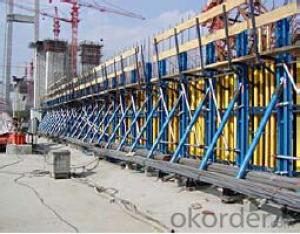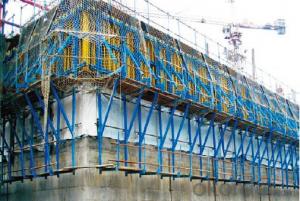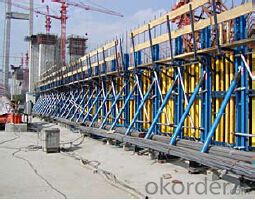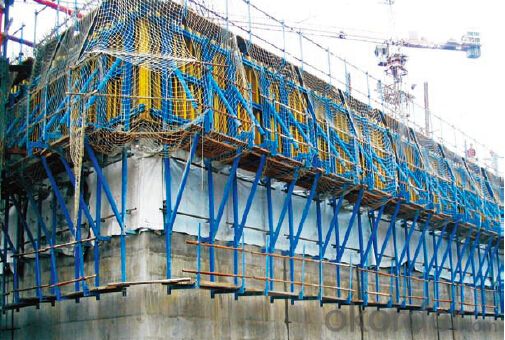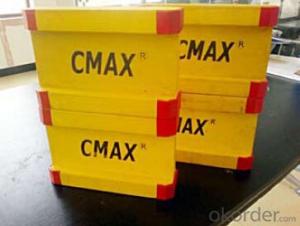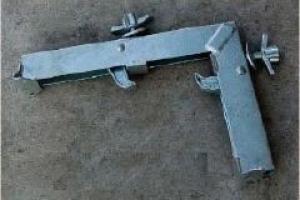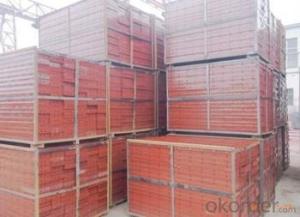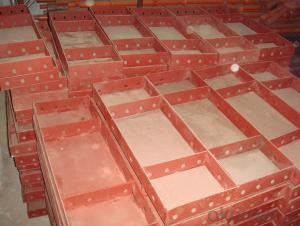Single-side climbing bracket for formwork and scaffolding system
- Loading Port:
- Tianjin
- Payment Terms:
- TT OR LC
- Min Order Qty:
- 50 m²
- Supply Capability:
- 1000 m²/month
OKorder Service Pledge
OKorder Financial Service
You Might Also Like
Single-side Climbing Bracket SCB180:
With CNBM SCB 180 climbing systems, the loads from the fresh concrete pressure are
transferred through the brackets by means of V-strongbacks and compression braces into the
scaffold anchors.
Typical applications for the SCB 180 are dams, locks, cooling towers, pier heads, tunnels, and
bank vaults.
The formwork is simply tilted backwards when striking takes place. The 1.80 m wide bracket
requires only a minimum of space.
Characteristics:
◆ Economical and safe anchoring
The M30/D20 climbing cones have been designed especially for single-sided concreting using
SCB180 in dam construction, and to allow the transfer of high tensile and shear forces into the still
fresh, unreinforced concrete. Without wall-through tie-rods, finished concrete is perfect.
◆ Stable and cost-effective for high loads
generous bracket spacings allow large-area formwork units with optimal utilization of the bearing
capacity. This leads to extremely economical solutions.
◆ Simple and flexible planning
With SCB180 single-sided climbing formwork, circular structures can also be concreted without
undergoing any large planning process. Even use on inclined walls is feasible without any special
measures because additional concrete loads or lifting forces can be safely transferred into the
structure.
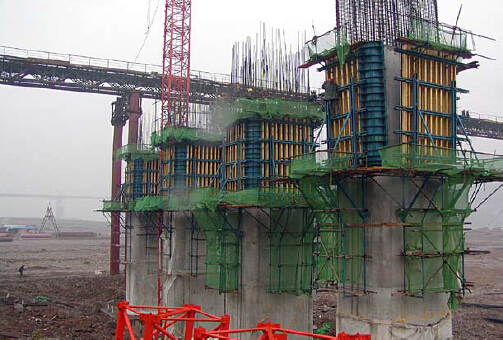
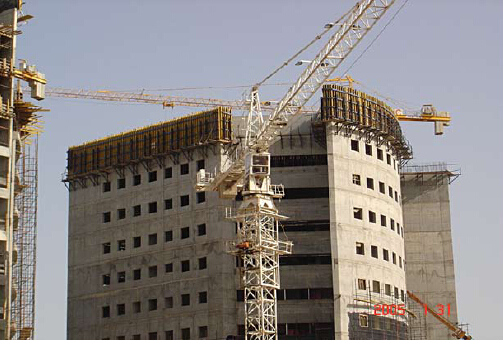
- Q: How does steel formwork contribute to the efficiency of construction processes?
- Steel formwork contributes to the efficiency of construction processes by providing a durable and reusable framework for casting concrete structures. Its strength and rigidity allow for faster construction progress, as it can withstand the pressure exerted by wet concrete, resulting in shorter construction cycles. Additionally, steel formwork allows for precise and accurate shaping of concrete elements, ensuring the desired dimensions and quality of the final product. Its reusability minimizes waste, reduces costs, and promotes sustainability in construction projects.
- Q: Can steel formwork be used for both manual and mechanical concrete pouring?
- Indeed, both manual and mechanical concrete pouring can utilize steel formwork. Renowned for its robustness and sturdiness, steel formwork is apt for handling the immense pressure and weight of concrete, regardless of the pouring method employed. It furnishes a steadfast and inflexible framework that endures the strains exerted during the pouring and setting of concrete. Moreover, steel formwork is adaptable and can be effortlessly modified or reconstructed to accommodate diverse configurations and dimensions of concrete structures. Consequently, it is frequently employed in construction ventures that employ both manual and mechanical concrete pouring techniques.
- Q: What are the different types of connections used in steel formwork construction?
- Steel formwork construction utilizes various types of connections, each serving a specific purpose. 1. Bolted connections, the most commonly used type, involve securing steel formwork components together using bolts, nuts, and washers. This connection provides a strong and rigid joint that is easy to assemble and disassemble. 2. Welded connections fuse steel formwork components together using heat and pressure. They are ideal for permanent structures or situations requiring high strength and rigidity. However, welded connections are time-consuming and require skilled labor. 3. Clamped connections utilize clamps or brackets to hold steel formwork components together. This connection type is suitable for temporary structures or frequent disassembly/reassembly, as it is quick to assemble and disassemble and does not require specialized skills or equipment. 4. Interlocking connections employ specially designed mechanisms, such as tabs, slots, or grooves, to connect steel formwork components. These connections are commonly used in modular formwork systems, where fast and easy assembly is necessary. 5. Adhesive connections involve bonding steel formwork components together using epoxy or other adhesive materials. This connection type provides a seamless and smooth joint, often used for architectural or decorative purposes. Proper surface preparation and curing time are essential for achieving maximum strength. In summary, the choice of connection type in steel formwork construction depends on factors such as desired strength and rigidity, structure type, reusability, and available resources and expertise. It is crucial to select the appropriate connection type to ensure the safety and stability of the formwork system.
- Q: Can steel formwork be used in areas with high humidity levels?
- Steel formwork is indeed applicable in regions with elevated humidity levels. Steel possesses exceptional durability and resistance to corrosion, rendering it suitable for deployment in humid surroundings. Nevertheless, it remains crucial to guarantee meticulous maintenance and the application of protective coatings to avert rust and corrosion. Furthermore, utilizing steel formwork in areas with high humidity may necessitate more frequent examinations and upkeep to safeguard its longevity and structural soundness.
- Q: What are the standard dimensions of steel formwork panels?
- The standard dimensions of steel formwork panels can vary depending on the specific requirements and preferences of the construction project. However, there are common standard dimensions that are widely used in the industry. Typically, steel formwork panels are available in standard lengths ranging from 1 to 3 meters (3 to 10 feet), with a standard width of around 0.6 meters (2 feet). The thickness of the steel panels can also vary, but it is commonly around 12 to 16 millimeters (0.5 to 0.6 inches). These dimensions are designed to provide a strong and sturdy formwork system that can withstand the pressures and forces exerted during concrete pouring and curing. Additionally, these dimensions allow for easy handling and transportation of the formwork panels on the construction site. It is important to note that the dimensions of steel formwork panels can be customized to suit specific project requirements. This flexibility allows for the creation of unique formwork systems that can accommodate various shapes and sizes of concrete structures.
- Q: Can steel formwork be used for both residential and industrial construction projects?
- Yes, steel formwork can be used for both residential and industrial construction projects. Steel formwork is a versatile and durable solution that can withstand the demands of various construction projects. It offers a high level of strength and stability, making it suitable for both small-scale residential projects and large-scale industrial projects. Additionally, steel formwork has the advantage of being reusable, which can help save costs and reduce waste in construction projects. It can be easily assembled and disassembled, making it a practical choice for different types of projects. Overall, steel formwork is a reliable and efficient option for both residential and industrial construction projects.
- Q: How does steel formwork handle different concrete reinforcement types?
- Steel formwork is a versatile and durable option for handling different types of concrete reinforcement. It is commonly used in construction projects to create temporary molds or structures to hold concrete in place during the pouring and curing process. One of the advantages of steel formwork is its ability to handle different concrete reinforcement types. Whether it is traditional reinforcement such as steel bars or modern reinforcement techniques like fiber-reinforced polymers (FRP), steel formwork can accommodate them all. Steel formwork is designed to be strong and rigid, which allows it to support the weight and pressure exerted by different types of reinforcement materials. Whether it is the weight of steel bars or the tensile strength of FRP, steel formwork can withstand these forces without deforming or collapsing. Additionally, steel formwork is highly adaptable and can be easily adjusted or modified to accommodate different reinforcement types. It can be cut or welded to create openings or recesses for steel bars or other reinforcement materials to pass through. This flexibility ensures that steel formwork can be customized to suit the specific needs of each construction project. Furthermore, steel formwork offers a smooth and even surface finish, which is crucial for ensuring proper adhesion between the concrete and the reinforcement materials. This ensures that the reinforcement is securely embedded within the concrete structure, providing the necessary structural integrity and strength. In conclusion, steel formwork is a reliable and effective solution for handling different concrete reinforcement types. Its strength, adaptability, and ability to provide a smooth surface finish make it an ideal choice for construction projects that require diverse reinforcement materials.
- Q: I would like to ask, large steel formwork and the average number of square meters of a template?
- You can find the local rental station under the general template is charged by the day rental fees
- Q: Can steel formwork be used for both slab and column construction?
- Yes, steel formwork can be used for both slab and column construction. Steel formwork offers several advantages over other types of formwork, such as wood or plastic. It is highly durable and can withstand the pressure exerted by fresh concrete, making it suitable for use in both slab and column construction. For slab construction, steel formwork provides a strong and rigid support system, ensuring that the concrete is poured and cured in the desired shape and dimensions. The steel panels can be easily assembled and disassembled, allowing for efficient and repeated use on multiple projects. This saves both time and money in the long run. Similarly, steel formwork can also be used for column construction. The adjustable panels can be easily customized to various column sizes and shapes, providing flexibility in design. Steel formwork also offers a smooth surface finish, resulting in high-quality columns. Moreover, steel formwork is resistant to warping, swelling, and shrinking, which can occur with other types of formwork materials. This ensures that the concrete structure is built accurately and maintains its structural integrity over time. Overall, steel formwork is a versatile and reliable option for both slab and column construction. Its strength, durability, and ease of use make it a popular choice among construction professionals.
- Q: How does steel formwork handle concrete vibration and air entrapment?
- Steel formwork is widely recognized for its effectiveness in managing concrete vibration and reducing air entrapment during pouring and curing. To begin with, the strength and rigidity of steel formwork make it capable of withstanding the intense vibrations caused by compacting concrete. When poured into steel formwork, the formwork acts as a barrier, preventing excessive movement or deformation that could lead to the creation of voids or air pockets. This ensures that the concrete is evenly distributed and compacted throughout the structure. Moreover, steel formwork is designed with tight joints and smooth surfaces, which aids in minimizing air entrapment. The joints are securely sealed to prevent any leakage that could result in air getting trapped within the concrete. This is particularly crucial as air pockets have the potential to weaken the structural integrity and durability of the concrete. The smooth surfaces also facilitate the smooth flow and consolidation of the concrete, reducing the likelihood of air entrapment. Additionally, steel formwork can be easily customized and adjusted to meet the specific requirements of the construction project. This allows for precise and accurate placement of the formwork, ensuring that the concrete is poured and compacted in the desired manner. By maintaining complete control over the formwork, the risk of air entrapment can be minimized, resulting in a more durable and reliable concrete structure. In conclusion, steel formwork is an excellent choice for managing concrete vibration and air entrapment. Its strength, rigidity, tight joints, and smooth surfaces provide the necessary stability and control during the pouring and compacting process. By utilizing steel formwork, construction professionals can guarantee that the concrete is properly consolidated and free from air pockets, leading to a high-quality and long-lasting structure.
Send your message to us
Single-side climbing bracket for formwork and scaffolding system
- Loading Port:
- Tianjin
- Payment Terms:
- TT OR LC
- Min Order Qty:
- 50 m²
- Supply Capability:
- 1000 m²/month
OKorder Service Pledge
OKorder Financial Service
Similar products
Hot products
Hot Searches
